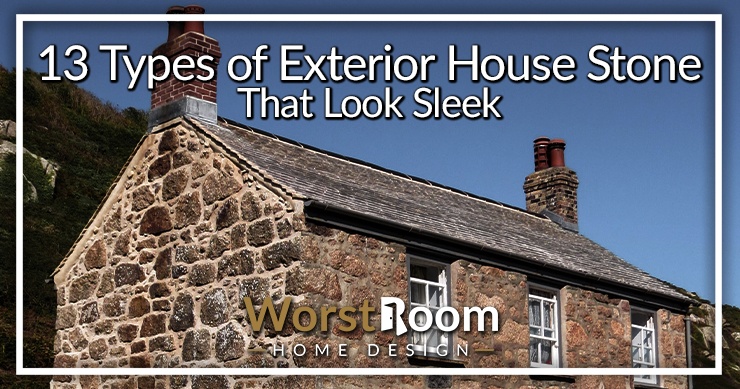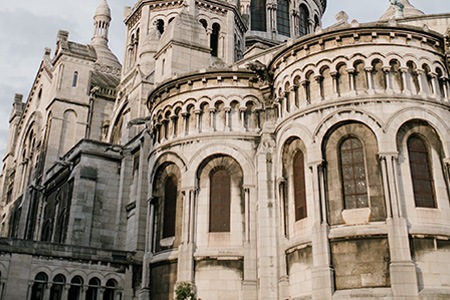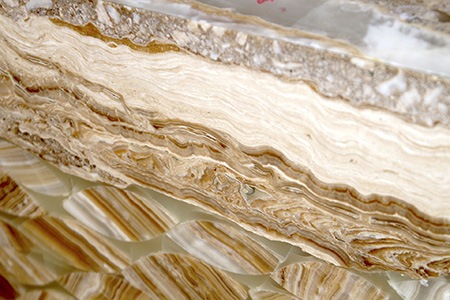13 Types of Exterior House Stone That Look Sleek
Author: Rick Worst | Editor: Omar Alonso
Review & Research: Jen Worst & Chris Miller

Any of the types of exterior house stone can give your home a rustic yet contemporary look, making them quite ideal for your curb appeal and maintenance needs. They not only look natural and attractive, but are also quite durable.
Of course, natural stone materials are ideal options as stone siding here, but you can also consider materials that provide a stone-like look if this is what you prefer, albeit manufactured.
13 Types of Exterior House Stone
If you want to spruce up your house exteriors, here are some types of stone materials that you can consider using. Make sure you consider factors like cost, appearance, surface area, climatic conditions and longevity before you make your decision, as compared not only to each other but to types of wood siding and other options.
Gneiss

Gneiss is a metamorphic rock and usually tends to feature distinct black, brown and white bands throughout its surface. These bands can also take several shapes, some being straight and uniform, while others are more uneven and wavy.
This is a natural occurrence that occurs due to the effect of mineral distribution and temperature conditions. Using this kind of coarse yet appealing natural stone on the exterior of your house can provide a sturdy solution. In fact, it is quite popularly used for carrying out building and construction work.
You can also make gneiss shinier and glossier after you put it together. You can also break it up into distinct blocks to create patterns on your stone exterior.
Sandstone

Sandstone is a sedimentary rock. It forms as a result of sand silicate particles combining and hardening over time and due to high temperatures to form a rock.
This stone is extremely hard, tough and durable, making it quite a reliable and popular choice when it comes to exterior house walls and other architectural projects.
Sandstone not only comes in standard brown shades but can also come in occasional shades of light purple, pink, white, orange and yellow, sometimes also containing a combination of these.
Since sandstone can reflect plenty of light, it can be a good choice for hot climates as an exterior stone veneer but you don't want to blind everyone looking in the direction of your home either.
Steatite

Steatite, also called soapstone, can be ideal for exterior projects if you are looking for gray and similar adjacent colors. You can also find this stone in white and, albeit rarely, brown.
Steatite are extremely sturdy and dependable types of exterior house stone. This metamorphic rock contains a large quantity of the mineral talc, which can make this stone quite long lasting and strong. It can also resist quite a bit of heat, making it ideal for different weather conditions.
Quite commonly, people tend to use steatite for insulation, although it can work perfectly for larger wall-like structures and as a stone for house exteriors or projects such as statues and garden structures. It is one you can easily carve.
Slate

Another metamorphic rock, slate can work well for wall siding along the exterior of your house. You can also use it for smaller structures that you want to situate outside your house. Slate can perform well in all sorts of climates, whether it gets too hot or too cold. They can resist water to a large extent too.
This stone for the outside of your house is easy to clean, stands at low risk of cracking and can retain its quality for a long time. It can also provide a clean and sleek look to your home’s exterior.
Additionally, slate comes in darker shades and colors, such as gray and black, which can enhance the look of your house and even be used on better looking types of sheds you may have built in the backyard.
Quartzite

Quartzite is an extremely tough and hard metamorphic stone. It can give off a twinkling and glistening look wherever it is installed, making it appealing enough for exterior walls, siding and structures.
This stone exterior is highly dependable, so you can easily rely on it to maintain its quality and condition come rain or shine. It can do well even in the cold. It can withstand these weather changes in addition to several chemicals and pollutants, keeping it neat and easy to maintain.
Quartzite, in terms of stone siding options, usually comes in colors like white and gray, with other shades often available if a variety of minerals were involved in its formation. This is a classic stone for outside of house exteriors, as well as sturdy sheds.
Granite

Granite is an igneous rock. It is commonly used in architectural and building projects, especially when it comes to the exteriors of houses. Granite tends to be coarse, having been formed as a result of the action of several minerals and magma.
Granite usually offers a granular appearance alongside a durable and steady presence outside your house. It can withstand all sorts of weather conditions. It also looks quite shiny and smooth, especially after polishing.
Granite stone siding comes in colors like gray, black, white, pink and brown. However, granite can be a bit expensive not only in terms of installation but also in its maintenance compared to other types of natural stone for house exteriors.
Travertine

These sedimentary types of exterior house stone come in colors like tan, white, brown, pink, cream as well as some light shades of rust. It contains plenty of calcium, giving it its strong and durable quality.
Travertine stones can also often contain patterns and shapes as a result of natural processes and gaps. Usually, if these gaps remain, they can be filled up using other building materials.
This stone can work pretty well for exterior structures if you live in a hot climate, although it might not suit extremely cold conditions too well. It also remains clean and smooth and can withstand quite a bit of pressure.
Onyx

Onyx is a stone that has a large composition of silica. It has several bands and grains in its appearance and usually comes in darker colors, such as gray, brown and black. Onyx can give your exterior house structure a good shiny and glossy appearance while also adding a bit of richness and opulence to it.
However, you should note that onyx isn’t highly popular as an exterior house stone since it’s hard to obtain. It also tends to be quite expensive.
Faux Stone

You might think that faux stone won’t provide the same kind of durability as natural stone. This is true to a large extent, but faux stone is still highly capable of durability and sturdiness.
Quite often, this faux stone comprises a combination of other building materials, a common one being polyurethane. Other materials include foam, small stone pieces and some cement.
This makes it quite convenient and affordable when it comes to installation, not to mention that it can be pretty easy to care for. It is also lighter than natural stone, so if your house can’t withstand too much weight, faux stone might be the way to go.
However, it might not work against harsh conditions or in large structures like exterior walls.
Marble

Marble is a metamorphic stone and includes plenty of carbonates. Marble is sleek, smooth and glossy and can provide an extremely luxurious appearance no matter which types of marble you choose. It is a common material used in making sculptures and carving and is also highly popular as a building and construction material.
Marble can be a bit heavy and brittle, but as long as you care for it properly while installing and maintaining it, you should be okay. It can, however, be a bit risky to use for external walls and siding unless you live in mild climates.
These types of exterior house stone can, however, resist water and cold temperatures pretty well. Marble, in the context of stone siding options, comes in colors like white, pink, gray, brown, purple and others.
Flint

Flint can be a good consideration for exterior house structures and walls since it can provide a unique textured appearance. It is also a durable stone and can withstand changing weather conditions, including moist and humid climates. This is perhaps one of the reasons why it tends to be so common in England.
As stone facing on houses, flint is quite versatile too since you can cut it up into smaller pieces and blocks while also forming patterns with it. Its colors include gray, brown, white, black and mossy green.
Limestone

This sedimentary rock is primarily made from carbonates, with lime being the predominant material as stone siding. It can add texture to your external siding, wall or structure and is also quite convenient to carve and shape. It is also highly durable, although stains and scratches can easily be visible on its surface unless you care for it properly.
Limestone is stable as well. It can provide a cooling effect, making it suitable for exteriors since it can minimize the heat entering the house. It can come in colors like white, gray, yellow and brown. Limestone and all the other listed exterior house stones can be used as types of pavers, too, but I recommend not matching the two together or you'll get a dull look that will appear to devalue the stone on your home's external wall surfaces.
Cement Stone

Cement stone is basically cement molded together to look like a stone exterior stone veneer. This can work for your house if you don’t want to use natural stone, not to mention that cement can be affordable as well. It can also be easier to make shapes and patterns using cement.
Usually, several other materials can also be mixed in with the cement to make it appear more realistic as a stone for house exteriors. You can also add several colors to this. Cement is also highly durable.
Types of Exterior House Stone to Add Value to Your Property
Flint, onyx, marble, gneiss, slate, quartzite, granite, limestone, sandstone, travertine, steatite and other stone materials can work well as exterior house stones. However, cement stone and faux stone can also do the trick sometimes, although natural stones are often more reliable choices if you truly want to capture the essence of the specific types of exterior house stone.



